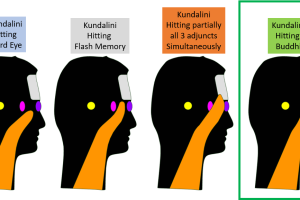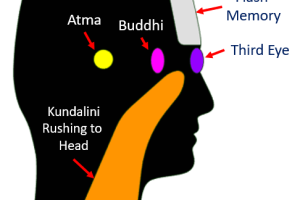Dance of Adjuncts-1: Ending the Drought of Samādhi
Samyama (from Sanskrit संयम saṃ-yama—holding together, tying up, binding) is the combined simultaneous practice of Dhāraṇā, Dhyāna and Samādhi.
saṃ-yama = Dharana + Dhyana + Samadhi
- Dhāraṇā : Deliberate linkage of attention to higher concentration force
- Dhyāna : Effortless linkage of attention to higher concentration force
- Samādhi : Continuous Effortless linkage of attention to higher concentration force
-------------------------------------------------------------------------------------------------------------------------------------------------------------
06 September, 2022, Houston, Texas, USA
3 pm CST
During the time of March -April 2022, everyday different types of samadhi were experienced, I can't even distinguish the types of samadhi states without Madhva's help and several Chit-Akash Access was given.
Disturbances:
After change in location and several tensions in moving to new place, the flow of Samyama was again disturbed to a considerable level. After April, with several tensions, hitting higher levels in Samayama became a big challenge.
Breath infusion practice did not stop, it was going in full swing, but the mento-emotional plain was greatly perturbed by change in outer circumstances and tensions.
Weakness, Area for Improvement:
This is a profound weakness. Initial stages of yoga are decently mastered but Samayama is a big area to improve.
Similar challenges were seen in Samayama alone when I went to India. It shows Chitta has certain affinity towards outer circumstances. The immunity needs to be developed.
Samadhi Attained:
After a longtime, today, more than 60 minutes (1 hour), Samadhi was established.
- Mento-emotional afflictions
- anxiety and restlessness from work and other factors were calmed down
- Chitta (mento-emotional plane) fluctuations were stopped
Few Subtle Changes were made in the practice to hit Buddhi again with Kundalini:
- Neck lock was not properly practiced (Madhva pointed it out)
- Kundalini hit the Third Eye and Flash Memory (Forehead)
- Brought sexual charge from Thigh to Buddhi using Frog pose
- Usually, other astral energy or other forms of kundalini brought to buddhi but it looks like buddhi loves sexual energy charged kundalini than another charged kundalini
- Astral energy from Buddha deity thru Acharya Mun helped me to navigate this drought of samadhi
Kundalini hitting different adjuncts:
- Kundalini hitting third Eye is good, it cleans third eye blockage and can see far away or other dimensions thru it.
- But without stopping the buddhi organ spinning, the third eye will full of whimsical images
- Kundalini hitting flash Memory is good
- the odd one is your flash memory will be erased so badly that you can't retain day to day work
- In my office work, I forgot my day to day tasks, I was getting reminded about my tasks
- It erases all stuff in flash memory, both good and bad, bad stuff is also erased, that's a good one
- the odd one is your flash memory will be erased so badly that you can't retain day to day work
- Kundalini hitting all 3 adjuncts
- This is more common in my case, all adjunct gets 1/3, 1/3, 1/3 or 0.2, 0.5, 0.3 such proportions of Kundalini charge.
- You get partial success in taming Buddhi, Flash Memory and Third eye
- But Buddhi will gain easily upper hand and start spinning again and create violent waves in the chitta (mento-emotional plane)
In all these 3 states, Pratyahara is a nightmare and it is very difficult to achieve pratyahara.
4. Kundalini hitting Buddhi is the perfect state, pratyahara happens smoothly effortlessly and one can go to higher states of Samyama easily. This is achieved by proper neck lock, very conscious neck lock.
In course of time, certain bandhas might get loosened up little bit, it can cause big deviation over time. This is one such example, where higher stages of Samyama were completely lost for over 4 months.


-
- · Michael Beloved
- ·
- Since the common language is English, sanskrit terms should be put in parenthesis. Otherwise English readers cannot follow the report. There is a habbit to use terms like samadhi and pratyahar as if these were part of common English usage.
- It is difficult to explain an experience in a language which may not have terms for describing that experience. But regardless if it is true that there are no equivalent terms in English, then it is also true that if those Sanskrit terms are use with an English speaking audience, those hearers will not understand the report.
- Make a check historically by reading the meanings given by persons like Vivekananda to see if these authorities give proper English meanings.
- Also check on the meanings in English by calling natives of India and asking those persons to give equivalent English terms.
- Once when I asked an American to show one of my books to a South Korean, the man said this: "There is no chance that a Korean could use your books because they do not have words in their language to define such states."
- What does that mean? So if the English language have no terms for certain experiences, then a description in their tongue will not be possible. Or would it?
-
Thanks for elucidating on this topic!
- Avoiding the Filler words
- Avoiding Sanskrit as a filler words is critical
- Need more proper definition and details on my report on this abstract terms, should avoid filler words!
- Avoiding the Filler words
-
- · Michael Beloved
- ·
Let us know if you ever call around to persons in or from India, to give their meaning for the terms like samadhi, pratyahar, dhyana, dharana, samyama. Are the Indians themselves knowledgeable about these terms?






